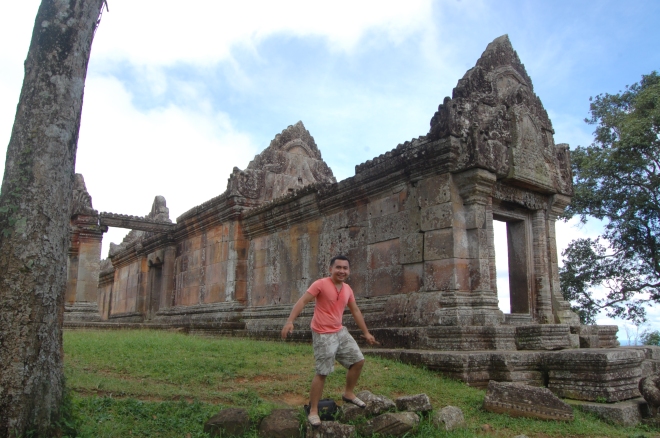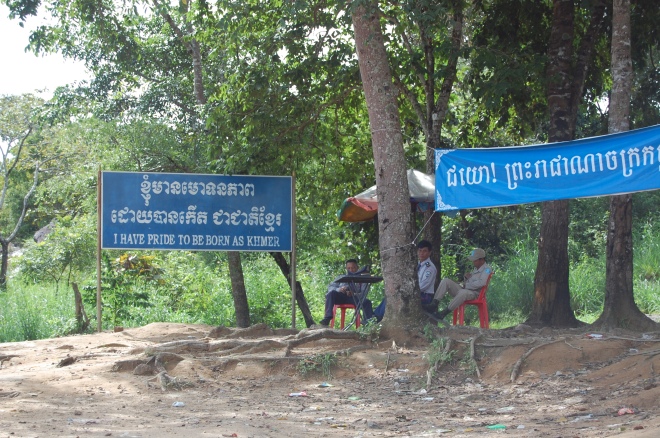When I found out that it was possible (albeit near-impossibility at that time) to visit this sacred temple on a day trip from Siem Reap in 2012, I immediately grabbed the opportunity to see it while it was then — once again — enjoying a short “time of peace”. For a very long time in the past, as a disputed territory, the promontory of the Temple of Preah Vihear and its environs have had some serious history of crossfires between the Cambodian and Thai military forces. In fact, a few months prior to my visit, several soldiers from both camps were killed in an unexpected clash.

Three years after that brave trip, as I look back, it is still perhaps the single most unique experience I have had in visiting a UNESCO World Heritage Site. Back then, it took me nearly four hours on a private vehicle to reach the temple from Siem Reap. Given the road constructions recently, the travel time is now reduced to nearly half of what it took when I went there.
The Temple of Preah Vihear never failed my towering expectations, to say the least. After all, it was confidently inscribed on only one criterium: “(i) as a masterpiece of human creative genius”. So far, only this temple, the Taj Mahal, and the Sydney Opera House are inscribed solely on this basis.

In my opinion, the temple rightly deserves to be on the same ranks as Angkor Wat and Bayon, if not even better. The incomparable beauty of this site stems from the following:
1. its history – older than those in Angkor, dedicated to Shiva and, according to some sources, is also one of a few that has a history of critical lingam worshiping;
2. its architecture – the extensive 800m-long layout of the temple is unique, the galleries surrounding the central sanctuary served as inspiration for the arrangement of Angkor Wat 300 years later, and the carvings offer a different style from those in Angkor (notice the style of its nagas, and the impressive quality of its carvings can only be compared to those of the much younger Banteay Srei) .

3. its relevance – a major pilgrimage site for Khmer kings, as well as a rare key temple off-route the Angkorian Royal Road;
4. its location – situated right beside a cliff, on top of the Dangrek Mountains to a height of nearly 600 metres. From the temple, one can already gaze at the Golden Triangle, an area shared by Cambodia, Thailand, and Laos; and, lastly,

5. the geopolitical struggles and controversies associated with its WHS-inscription in 2008, and the earlier landmark International Court of Justice (ICJ) ruling in 1962. More recently, in 2013, another ICJ ruling finally awarded the contested peripheral forest zone of the temple to Cambodia, putting an end to the long-standing dispute between the two Southeast Asian kingdoms.

As the Temple of Preah Vihear lies in an active military zone, it comes, then, as no surprise that not many travelers take the effort in seeing this site when I made my visit. In the five pleasurable hours that I spent there, I only managed to see about three other civilians — who might just be even locals — in the temple complex.
Aside from the breathtaking view from the top, I truly enjoyed receiving blessings by chanting monks guarding the central sanctuary; as well as exploring the interior of the largely ignored vegetated Tower of the Long-haired Lady that is reminiscent of Ta Prohm in Angkor.


Clearly, I got the strong impression that the Khmer people are indeed proud of the Temple of Preah Vihear as suggested by the displaying of the flags of UNESCO, Cambodia, and the World Heritage Committee not far from the first gopura. Such subtle declarations never fail to get noticed.
The temple of Preah Vihear together with its brother temple atop Phnom Chisor in the province of Takeo, which I also got the chance of visiting back in 2010, will always have special places in my heart for the wonderful experiences they have left me. In sum, the Temple of Preah Vihear clearly and easily justified itself as being one of the best single sites I have seen so far.

There is no entrance fee to the temple. But, at the base camp, visitors have to pay for the motorbike that will transport them to the top for a fairly reasonable price. On this trip, I also went to the nearby town of Anlong Veng, visiting some ‘Khmer Rouge’ related sites such as the house of Ta Mok and the final resting place of Pol Pot.
